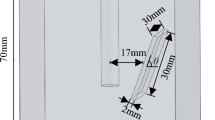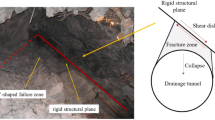Rocks and rock-like materials frequently fail under compression due to the initiation, propagation and coalescence of the pre-existing microcracks. The mechanism of microcrack coalescence process in rock-like materials is experimentally and numerically investigated. The experimental study involves some uniaxial compression tests on rock-like specimens specially prepared from portland pozzolana cement, mica sheets and water. The microcrack coalescence is studied by scanning electron microscopy on some of the prepared thin specimens. It is assumed that the mica sheets play the role of microcracks within the specimens. Some analytical and numerical studies are also carried out to simulate the experimentally observed microcrack coalescence phenomena within the specimens. A higher-order indirect boundary element method known as higher-order displacement discontinuity method implementing special crack tip elements to treat the singularities of stress and displacement fields near the crack ends is used to estimate the Mode I and Mode II stress intensity factors at the microcrack tips. The maximum tangential stress fracture criterion is implemented in a sophisticated computer code using the linear elastic fracture mechanics theory and the propagation and coalescence of random microcracks within the rock-like specimens are numerically simulated based on an iterative algorithm. The proposed analyses are validated by comparing the corresponding experimental and numerical results of microcrack coalescence phenomena of rock-like materials.














Similar content being viewed by others
References
M. Bahaaddini, G. Sharrock, and B. K. Hebblewhite, “Numerical investigation of the effect of joint geometrical parameters on the mechanical properties of a non-persistent jointed rock mass under uniaxial compression,” Comput. Geotech., 49, 206–225 (2013).
L. N. Y. Wong and H. Q. Li, “Numerical study on coalescence of two pre-existing coplanar flaws in rock,” Int. J. Solids Struct., 50, 3685–3706 (2013).
E. Mohtarami, A. Jafari, and M. Amini, “Stability analysis of slopes against combined circular-toppling failure,” Int. J. Rock Mech. Min. Sci., 67, 43–56 (2014).
T. Funatsu, M. Kuruppu, and K. Matsui, “Effects of temperature and confining pressure on mixed mode (I–II) and mode II fracture toughness of Kimachi sandstone,” Int. J. Rock Mech. Min. Sci., 67, 1–8 (2014).
R. L. Kranz, “Crack-crack and crack-pore interactions in stressed granite,” Int. J. Rock Mech. Min. Sci. Geomech. Abstr., 16, 37–47 (1979).
C. A. Tang, P. Lin, R. H. C. Wong, and K. T. Chau, “Analysis of crack coalescence in rock-like materials containing three flaws – Part II: Numerical approach,” Int. J. Rock Mech. Min. Sci., 38, 925–939 (2001).
M. Sagong and A. Bobet, “Coalescence of multiple flaws in a rock-model material in uniaxial compression,” Int. J. Rock Mech. Min. Sci., 39, 229–241 (2002).
M. H. B. Nasseri and B. Mohanty, “Fracture toughness anisotropy in granitic rocks,” Int. J. Rock Mech. Min. Sci., 45, 167–193 (2008).
A. Golshani, M. Oda, T. Takemura, and E. Munkhtogoo, “Numerical simulation of the excavation damaged zone around an opening in brittle rock,” Int. J. Rock Mech. Min. Sci., 44, 835–845 (2006).
Y. Ichikawa, K. Kawamura, K. Uesugi, et al., “Micro- and macrobehavior of granitic rock: observations and viscoelastic homogenization analysis,” Comput. Meth. Appl. Mech. Eng., 191, 47–72 (2001).
B. Obara, “Application of the image analysis method to the detection of transcrystalline microcracks observed in microscope images,” Arch. Min. Sci., 50, 537–551 (2005).
M. F. Marji and E. Dehghani, “Kinked crack analysis by a hybridized boundary element/boundary collocation method,” Int. J. Solids Struct., 47, 922–933 (2010).
M. F. Marji, “Numerical analysis of quasi-static crack branching in brittle solids by a modified displacement discontinuity method,” Int. J. Solids Struct., 51, 1716–1736 (2014).
H. Horii and S. Nemat-Nasser, “Compression-induced microcrack growth in brittle solids: axial splitting and shear failure,” J. Geophys. Res., 90, 3105–3125 (1985).
B. Shen, O. Stephansson, H. H. Einstein, and B. Ghahreman, “Coalescence of fractures under hear stress experiments,” J. Geoph. Res., 100, 5975–5990 (1995).
A. Bobet, Fracture Coalescence in Rock Materials: Experimental Observations and Numerical Predictions, Sc.D. Thesis, Massachusetts Institute of Technology, Cambridge, USA (1997).
A. Bobet and H. H. Einstein, “Fracture coalescence in rock-type materials under uniaxial and biaxial compression,” Int. J. Rock Mech. Min. Sci., 35, 863–888 (1998a).
J. Yoon, “Application of experimental design and optimization to PFC model calibration in uniaxial compression simulation,” Int. J. Rock Mech. Min. Sci., 44, 871–889 (2007).
C. H. Park, Coalescence of Frictional Fractures in Rock Materials, Ph.D. Thesis, Purdue University, West Lafayette, Indiana (2008).
L. N. Y. Wong and H. H. Einstein, “Systematic evaluation of cracking behavior in specimens containing single flaws under uniaxial compression,” Int. J. Rock Mech. Min. Sci., 46, 239–249 (2009).
C. H. Park and A. Bobet, “Crack initiation and propagation from frictional fractures,” in: Proc. of the 1st Canada-US Rock Mechanics Symposium (May 27–31, 2007, Vancouver, Canada) (2007), pp. 557–564.
C. H. Park and A. Bobet, “Crack coalescence in specimens with open and closed flaws: A comparison,” Int. J. Rock Mech. Min. Sci., 46, 819–829 (2009).
C. H. Park and A. Bobet, “Crack initiation, propagation and coalescence from frictional flaws in uniaxial compression,” Eng. Fract. Mech., 77, 2727–2748 (2010).
H. Lee and S. Jeon, “An experimental and numerical study of fracture coalescence in pre-cracked specimens under uniaxial compression,” Int. J. Solids Struct., 48, 979–999 (2011).
P. Cheng-zhi and C. Ping, “Failure characteristics and its influencing factors of rock-like material with multi-fissures under uniaxial compression,” Trans. Nonferrous Met. Soc. China, 22, 185–191 (2012).
G. R. Irwin, “Analysis of stresses and strain near the end of crack traversing a plate,” J. Appl. Mech., 24, 361–364 (1957).
F. Erdogan and G. C. Sih, “On the crack extension in plates under loading and transverse shear,” J. Basic Eng., 85, 519–527 (1963).
M. A. Hussian, E. L. Pu, and J. H. Underwood, “Strain energy release rate for a crack under combined mode I and mode II,” in: Fracture Analysis, ASTM STP 560 (1974), pp. 2–28.
G. C. Sih, “Strain-energy-density factor applied to mixed mode crack problems,” Int. J. Fract., 10, 305–321 (1974).
B. Shen and O. Stephansson, “Modification of the G-criterion for crack propagation subjected to compression,” Eng. Fract. Mech., 47, 177–189 (1994).
B. N. Whittaker, R. N. Singh, and G. Sun, Rock Fracture Mechanics: Principles, Design and Applications. Developments in Geotechnical Engineering, Elsevier, Amsterdam (1992).
L. F. Vesga, L. E. Vallejo, and S. Lobo-Guerrero, “DEM analysis of the crack propagation in brittle clays under uniaxial compression tests,” Int. J. Num. Anal. Meth. Geomech., 32, 1405–1415 (2008).
F. Ouchterlony (ISRM Commission on Testing Methods), “Suggested methods for determining the fracture toughness of rock,” Int. J. Rock Mech. Min. Sci. Geomech. Abstr., 25, 71–97 (1988).
R. J. Fowell (ISRM Commission on Testing Methods), “Suggested method for determining mode I fracture toughness using cracked chevron notched Brazilian disc (CCNBD) specimens,” Int. J. Rock Mech. Min. Sci. Geomech. Abstr., 32, 57–64 (1995).
H. Guo, N. I. Aziz, and R. A. Schmidt, “Linear elastic crack tip modeling by displacement discontinuity method,” Eng. Fract. Mech., 36, 933–943 (1990).
H. Guo, N. I. Aziz, and R. A. Schmidt, “Rock cutting study using linear elastic fracture mechanics,” Eng. Fract. Mech., 41, 771–778 (1992).
C. Scavia, “Fracture mechanics approach to stability analysis of crack slopes,” Eng. Fract. Mech., 35, 889–910 (1990).
M. H. Aliabadi and D. P. Rooke, Numerical Fracture Mechanics, Computational Mechanics Publications, Southampton, UK (1991).
M. H. Aliabadi, Fracture of Rocks, Computational Mechanics Publications, Southampton, UK (1998).
H. Haeri, K. Shahriar, M. F. Marji, and P. Moarefvand, “On the strength and crack propagation process of the pre-cracked rock-like specimens under uniaxial compression,” Strength Mater., 46, No. 1, 140–152 (2014).
R. J. Sanford, Principles of Fracture Mechanics, Pearson Education, Upper Saddle River, New Jersey (2003), pp. 1–15.
Author information
Authors and Affiliations
Corresponding author
Additional information
Translated from Problemy Prochnosti, No. 5, pp. 109 – 125, September – October, 2015.
Rights and permissions
About this article
Cite this article
Haeri, H., Khaloo, A. & Marji, M.F. Experimental and Numerical Simulation of the Microcrack Coalescence Mechanism in Rock-Like Materials. Strength Mater 47, 740–754 (2015). https://doi.org/10.1007/s11223-015-9711-6
Received:
Revised:
Published:
Issue Date:
DOI: https://doi.org/10.1007/s11223-015-9711-6




